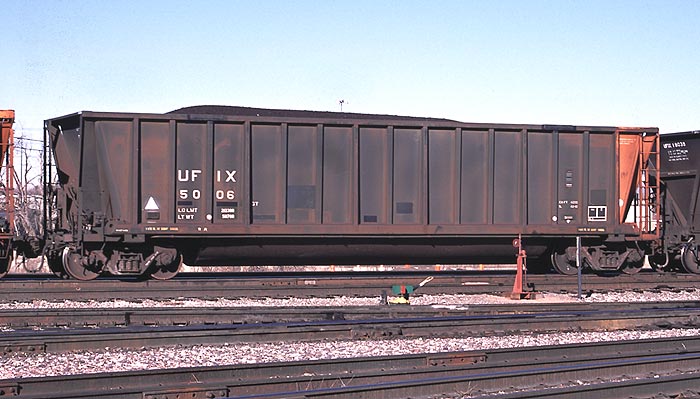Prototype History: Built in the 1980's by ACF®, the Coalveyor Bathtub Gondola operated in unit train service to deliver coal to power plants. These cars were most often lettered for the utility companies that leased and purchased them. Many are still in service today.
C&D cars were usually run in blocks of 4-12 cars. They were used for construction and demolition debris/refuse hauling.
C&D cars were usually run in blocks of 4-12 cars. They were used for construction and demolition debris/refuse hauling.
Road Name History:  The Wisconsin and Southern Railroad (reporting mark WSOR) is a Class II regional railroad in southern Wisconsin and northeastern Illinois. It operates former Chicago, Milwaukee, St. Paul and Pacific Railroad (Milwaukee Road) and Chicago and North Western Transportation Company (C&NW) trackage, mostly acquired by the state of Wisconsin in the 1980s.
The Wisconsin and Southern Railroad (reporting mark WSOR) is a Class II regional railroad in southern Wisconsin and northeastern Illinois. It operates former Chicago, Milwaukee, St. Paul and Pacific Railroad (Milwaukee Road) and Chicago and North Western Transportation Company (C&NW) trackage, mostly acquired by the state of Wisconsin in the 1980s.
Within Wisconsin, WSOR connects with four western Class I railroads: BNSF Railway, Canadian National Railway, Canadian Pacific Railway and Union Pacific Railroad. Through trackage rights over Metra, WSOR accesses Chicago to connect with the two eastern Class I railroads, CSX Transportation and the Norfolk Southern Railway. WSOR also has access to harbor facilities in Prairie du Chien, and transload facilities are located in Milwaukee, Janesville, Madison, and Oshkosh. 22 grain elevators have located rail load-out facilities on the WSOR system.

Within Wisconsin, WSOR connects with four western Class I railroads: BNSF Railway, Canadian National Railway, Canadian Pacific Railway and Union Pacific Railroad. Through trackage rights over Metra, WSOR accesses Chicago to connect with the two eastern Class I railroads, CSX Transportation and the Norfolk Southern Railway. WSOR also has access to harbor facilities in Prairie du Chien, and transload facilities are located in Milwaukee, Janesville, Madison, and Oshkosh. 22 grain elevators have located rail load-out facilities on the WSOR system.
Brand/Importer Information: In 1924 Stephan Schaffan, Sr. founded the Atlas Tool Company in Newark, New Jersey. In 1933 his son, Stephan Schaffan, Jr., came to work for his father at the age of sixteen. Steve Jr. built model airplanes as a hobby and frequented a local hobby shop. Being an enterprising young man, he would often ask the owner if there was anything he could do to earn some extra spending money. Tired of listening to his requests, the hobby-store owner threw some model railroad track parts his way and said, "Here, see if you can improve on this".
In those days, railroad modelers had to assemble and build everything from scratch. Steve Jr. created a "switch kit" which sold so well, that the entire family worked on them in the basement at night, while doing business as usual in the machine shop during the day.
Subsequently, Steve Jr. engineered the stapling of rail to fiber track, along with inventing the first practical rail joiner and pre-assembled turnouts and flexible track. All of these products, and more, helped to popularize model railroading and assisted in the creation of a mass-market hobby. The budding entrepreneur quickly outgrew the limitations of a basement and small garage operation. Realizing they could actually make a living selling track and related products, Steve and his father had the first factory built in Hillside, New Jersey at 413 Florence Avenue in 1947. On September 30, 1949, the Atlas Tool Company was officially incorporated as a New Jersey company.
In 1985, Steve was honored posthumously for his inventions by the Model Railroad Industry Association and was inducted into the Model Railroad Industry Hall of Fame in Baltimore, Maryland. In addition, Steve was nominated and entered into the National Model Railroad Association Pioneers of Model Railroading in 1995.
In the early 1990s, the Atlas Tool Company changed its name to Atlas Model Railroad Company, Inc.
In those days, railroad modelers had to assemble and build everything from scratch. Steve Jr. created a "switch kit" which sold so well, that the entire family worked on them in the basement at night, while doing business as usual in the machine shop during the day.
Subsequently, Steve Jr. engineered the stapling of rail to fiber track, along with inventing the first practical rail joiner and pre-assembled turnouts and flexible track. All of these products, and more, helped to popularize model railroading and assisted in the creation of a mass-market hobby. The budding entrepreneur quickly outgrew the limitations of a basement and small garage operation. Realizing they could actually make a living selling track and related products, Steve and his father had the first factory built in Hillside, New Jersey at 413 Florence Avenue in 1947. On September 30, 1949, the Atlas Tool Company was officially incorporated as a New Jersey company.
In 1985, Steve was honored posthumously for his inventions by the Model Railroad Industry Association and was inducted into the Model Railroad Industry Hall of Fame in Baltimore, Maryland. In addition, Steve was nominated and entered into the National Model Railroad Association Pioneers of Model Railroading in 1995.
In the early 1990s, the Atlas Tool Company changed its name to Atlas Model Railroad Company, Inc.
Item created by: Emily on 2017-01-08 15:14:02
If you see errors or missing data in this entry, please feel free to log in and edit it. Anyone with a Gmail account can log in instantly.
If you see errors or missing data in this entry, please feel free to log in and edit it. Anyone with a Gmail account can log in instantly.










